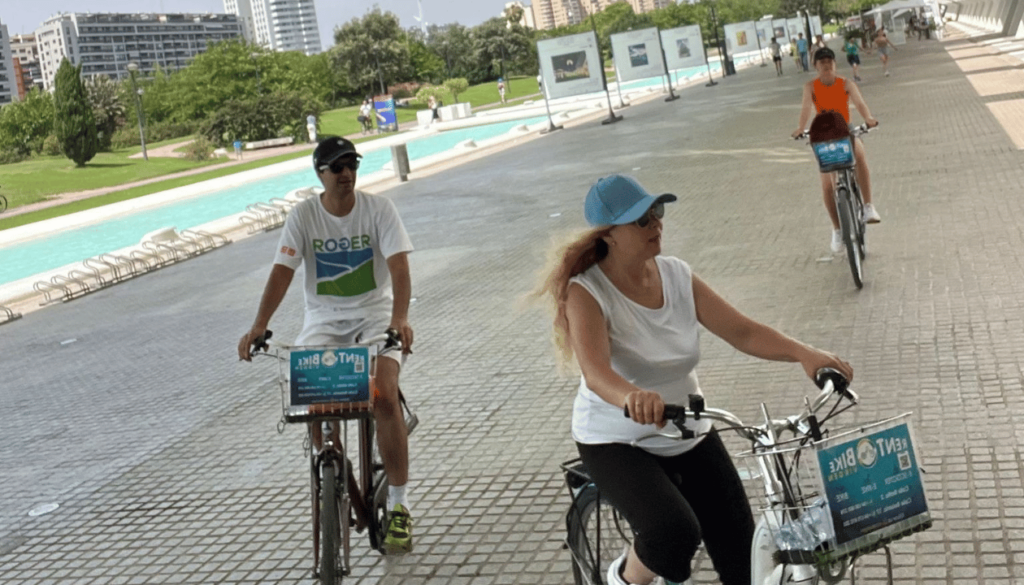

Spain’s breathtaking coastlines, medieval towns, and bustling cities are waiting to be explored—but how you get from one to another can make or break your journey. From the vibrant heart of Valencia to the beachside charm of Barcelona, navigating the country efficiently is key.
Spain’s public transport offers a wide variety of options, whether you’re traveling between major cities or exploring small towns. With well-connected metro networks, long-distance buses, and high-speed trains, getting around has never been easier.
This guide will walk you through Spain’s transport options to ensure you make the most of your time in this beautiful country.

Spain’s transport network overview
Spain’s transport network is one of the most efficient in Europe, offering various options to get around. Spain’s national railway company operates high-speed trains, connecting major cities in less than two hours.
Most Spanish cities have well-established metro networks, making it easy to travel within city centers. Long-distance buses also provide direct connections to small towns and rural areas. For island-hopping, ferries and domestic flights link Spain’s main islands.
Public transportation runs daily from 6 am to 11 pm, providing convenient options for both locals and tourists. Whether you’re traveling by train, bus, or metro, Spain’s transport is reliable and accessible.
How to move around cities

Metro in Spanish cities
The metro is one of the most efficient ways to get around in Spain’s major cities, like Barcelona and Valencia. With easy-to-navigate, color-coded lines, it’s simple to travel between city centers and major destinations.
Travel cards offer big savings for frequent riders, especially for tourists planning to explore the city over a few days. Most stations are accessible, making it easy for wheelchair users and those with luggage to travel without hassle.

City buses in Spain
City buses in Spain are frequent, reliable, and cost-effective, making them an excellent option for getting around. Unlike metros, buses can reach areas metros do not, including smaller towns and scenic spots.
Apps like Google Maps or Moovit can help with route planning, and most bus companies accept travel cards, which you can load with credits for easy use. The bus service runs smoothly, and buses tend to run more frequently during peak hours, so you won’t have to wait long for your ride.

Trams and light rail options
Trams and light rail options are available in many cities, offering a clean, modern, and well-integrated mode of transport. Trams are especially useful for shorter, scenic routes and are a pleasant way to see the city’s sights while traveling from one point to another.
These services connect areas that may not be served by metros, making them a great choice for those looking to explore the city at a slower pace.

Taxis and app-based services
Taxis in Spain are easy to spot with clear signage and meters. Official taxis are reliable, and you’ll often find them parked at designated stands in city centers. In major cities, services like Uber and Cabify are also widely available, making it convenient to hail a ride from your smartphone.
Taxis are especially useful during late hours when public transport isn’t running, or when you’re in quieter areas. They are also great for day trips or carrying luggage. Just be sure to check that the meter is running!

Bike and scooter rentals
In cities like Barcelona, Cádiz, Sevilla, and Valencia, bike and scooter rentals are increasingly popular among locals and tourists alike. Electric scooters are particularly common, offering a quick and environmentally friendly way to navigate city streets.
These are great for short trips or exploring neighborhoods, and you can find many rental stations scattered across the city. Just make sure to follow local rules and safety laws, especially when it comes to riding on public transportation streets and sidewalks.

Best cities for walking
Spain’s historic centers in cities like Barcelona, Valencia, and Cádiz are perfect for exploring on foot. With their flat, compact streets, walking is often the best way to discover local gems and hidden corners of these charming cities.
Many places in the city center are pedestrian-friendly, and walking lets you truly soak in the culture and beauty of your surroundings. Whether you’re strolling through ancient streets or enjoying a peaceful park, these cities are designed for pedestrians to explore easily.

How to travel between cities
High-speed and regional trains
Spain’s railway network is one of the most advanced in Europe, offering high-speed trains like AVE, Alvia, and Intercity. AVE trains can reach speeds of up to 310 km/h, making travel between major cities like Madrid and Seville incredibly fast.
For more affordable options, AVLO provides a cheaper high-speed alternative, perfect for budget travelers.
Booking your tickets is easy through the Renfe website or various travel apps, and you can take advantage of seat reservations for a more comfortable journey. Whether traveling short distances or across mid distance, Spanish trains are the best for speed, comfort, and scenic views.

Buses across Spain
Spain’s intercity buses offer an extensive network that covers more than 5,000 towns and cities, making it easy to travel across the whole country. Major bus companies like ALSA and Avanza provide services to most major cities, and buses are often more affordable than trains, though they tend to be slower.
It’s recommended to book tickets online for the best prices. Most buses also offer amenities like Wi-Fi and luggage storage, ensuring comfort during your journey. Though slower, bus services are a great choice for reaching destinations not served by Spain’s railway network.

Domestic flights in Spain
Flying is ideal for long-distance trips or when traveling to Spain’s islands. With budget airlines like Vueling, Ryanair, and Iberia Express, flights to destinations like the Canary Islands or the Balearic Islands are both affordable and efficient.
Flights to Las Palmas or Palma de Mallorca are common, and booking early helps secure the best fares. If you’re traveling across Spain or to one of its islands, keep in mind that booking in advance often saves you money on ticket prices, especially during peak travel seasons. Flights offer a quick and convenient way to connect two points within the country.

Car rentals for road trips
For travelers seeking more flexibility, renting your own car is an excellent choice for exploring remote areas and scenic routes in regions like Andalusia and the Basque Country. It allows you to enjoy the freedom of stopping wherever you like.
However, be mindful of toll roads and parking rules when navigating busy cities or rural areas. If you’re not a Spanish resident, an international driving permit may be required. Car rentals are perfect for those looking to explore outside the main cities or venture into Spain’s beautiful countryside, offering a more personal travel experience.
Ferries to Spanish islands
Ferries are a great way to travel between the mainland and Balearic or Canary Islands. Operators like Balearia, Armas, Fred Olsen, and GNV provide services that make traveling by sea comfortable and enjoyable.
Ferries are equipped with comfortable cabins, and you can even bring your own car on board for extra convenience. If you’re traveling in the summer, it’s best to book tickets early to avoid sold-out routes. Ferries are a perfect way to reach some of Spain’s most beautiful islands and enjoy a leisurely journey with stunning coastal views.

Rideshare with BlaBlaCar
For budget-conscious travelers, BlaBlaCar offers an affordable and social way to travel long distances across Spain. You can book a seat in someone’s car via the app and share the ride to your destination. This option is popular for intercity travel and is a great way to meet locals or fellow travelers.
When using BlaBlaCar, always check driver reviews before confirming your ride. It’s a budget-friendly alternative to other transportation methods and is a great option for connecting two points in Spain on a personal level.
Pick transport that fits your trip

For budget travelers
If you’re looking to save money while getting around Spain, buses and AVLO trains are great options. They’re both affordable and comfortable, with buses covering many domestic routes and AVLO offering high-speed connections at a lower cost than regular AVE trains.
For further savings, look for multi-trip passes that offer discounts for frequent travel. If you can, avoid peak travel days to get cheaper fares and avoid crowded stations. Using these options will help you keep your costs down without compromising comfort.
For short city breaks
When visiting Spain for a short city break, sticking to the metro and buses is a great idea. These modes of transport are affordable and efficient for getting around city centers like Valencia and Barcelona.
For late-night or early morning travel, taxis are a good option, especially if you’re traveling with luggage. It’s also a good idea to skip renting a car in large cities, where parking can be difficult and expensive. Instead, make the most of public transport, which is well-connected and easy to navigate.
For families with kids
When traveling with children, trains are spacious and offer a family-friendly experience. Spanish trains provide plenty of room for families, and many trains offer reserved seats in dedicated family sections. Booking your seats in advance is a good idea, especially during busy seasons.
For a smoother journey, it’s best to avoid peak hours when the trains can get crowded. Spanish railway networks are safe and comfortable, making them a great choice for families on the go.
For scenic and relaxed travel
If you want to enjoy the scenery while traveling, AVE trains are perfect for exploring Spain’s beautiful countryside. These high-speed connections offer an excellent way to relax and take in the views as you travel.
For a more leisurely and flexible option, consider renting a car for coastal or mountain drives, especially in regions like Andalusia. If you’re traveling to the Balearic or Canary Islands, consider ferries for a relaxing journey that also gives you the chance to enjoy coastal views.

For accessible travel
Spain is committed to making travel accessible for everyone. Most metros and buses in major cities are equipped with lifts and ramps for ease of access. RENFE’s Atendo service provides additional support for passengers with reduced mobility, ensuring a smooth journey across the country.
Staff at train stations and on public transport are generally very helpful and polite, assisting with boarding and ensuring a comfortable experience for all passengers, including wheelchair users.
Practical tips for smooth travel

To ensure smooth travel across Spain, it’s essential to plan your routes ahead of time. Apps like Google Maps or Moovit are great for navigating metro lines and bus routes, helping you quickly connect city centers and plan your journey efficiently. Before traveling, be sure to check for any service alerts or strikes that might affect your plans, especially when trains run or buses might have delays.
When booking long-distance tickets, aim to do so 1–3 months ahead to secure the best prices and avoid added costs. Booking tickets early is also a good way to ensure seat reservations, especially for popular routes. In busy big cities, always keep an eye on your luggage in crowded areas like metro stations, such as Barcelona Metro or Madrid Metro, to avoid theft.
Consider using contactless cards or travel apps for quick and easy payments. Lastly, learning a few basic Spanish transport phrases can go a long way in helping you feel more confident, especially when you’re in other cities or smaller towns.
Travel smarter with Spanish Express
Planning your journey through Spain is just the first step—why not make it even more meaningful by learning Spanish along the way? At Spanish Express, we help you connect with Spain beyond the guidebook.
Whether you’re hopping on a high-speed train or exploring hidden gems on foot, knowing the language can transform your travel experience.
📚 Join our Spanish Homestay Immersion Programme (SHIP) in cities like Barcelona, Valencia, Cádiz, or Burgos and live with a certified Spanish teacher in their home.

🧳 Learn practical, real-life Spanish while exploring your destination through guided local experiences.
🎓 All levels welcome—from total beginners to advanced learners.
Make your journey across Spain not just unforgettable—but bilingual.
👉 Find your perfect SHIP destination now and travel like a local, not just a tourist.
Final thoughts to wrap up
Getting around Spain is easier than you think. With its reliable tram network, metros, and high-speed connections, you’ll find it simple to travel between city centers and explore even the more remote destinations.
If you’re using public transport in Valencia or taking a scenic train journey on media distancia routes, Spain offers something for every traveler. Compared to other European countries, Spain’s transport system stands out for its efficiency and affordability.
Be sure to buy tickets in advance for long journeys, especially if your flight departs soon. Whatever your travel needs, Spain’s transport options will ensure that your journey is as enjoyable as the sights you’ll see along the way.

